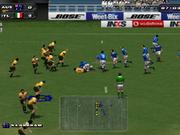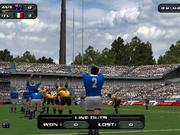Rugby 2004 for the PlayStation 2 expands on EA's previous Rugby game with a ton of new teams and tournaments. Unfortunately, the evolution really ends there since the gameplay and graphics, while better than they were in the original game, are certainly not on par with the standards set by Electronic Arts' other sports titles. As such, those who aren't already familiar with the sport of rugby likely won't gain interest from this game, while those who consider themselves fans probably won't be so impressed.

For those unfamiliar with the sport, Rugby can best be described as a mix of soccer and American football. Players are tasked with moving the ball from one side of the field to the other by either kicking or carrying it. As in football, teams can score one of two ways--either by running the ball into the opposing team's goal for five points or by kicking the ball through goalposts for three. While Rugby 2004 includes a training mode that teaches you about the mechanics of scrumming, line outs, and general play, there isn't an overall tutorial that teaches you the rules or any overview about the sport of rugby, so you really need to go in knowing what to expect, or you won't get too far.
Aside from the brief training and "play now" selection, the only other game mode offered in Rugby 2004 is tournament, which is the game's main mode of play. In all, Rugby 2004 includes seven different tournaments, including World Cup, Super 12, European Trophy, and World League. Aside from a few tournament-specific options, such as whether or not to have warm-up matches and the allowed number of trades, the only real differences between the tournaments are the number and lineup of participants. The number of teams offered in Rugby 2004 is a whopping 60, which is 40 more than were offered in Rugby 2002. In addition, Rugby 2004 contains upward of 2000 actual rugby players from all over the world as well as 75 different stadiums that also span the globe, from Australia to San Francisco. Plus, if your favorite team doesn't have a newly acquired player or if you'd like to try to build your own team, you can use points earned during play to either trade for players or create your own using the games create-a-player feature. This system of earning points for doing well works similar to the Madden card system, which awards points to the players for accomplishing individual goals. The goals in Rugby 2004 that players have to complete include tasks such as controlling the ball for 85 percent of the game and winning every single scrum in a game.
The gameplay and controls in Rugby 2004 are simple in design and allow you to tackle, switch players, and pass using the shoulder and face buttons on the controller. This year the game supports analog control, which allows you to move your players on the field. The control feels responsive when you're running with the ball, but as soon as you get tackled and the ball comes loose, things get confusing--you can't simply select the closest player to try to recover the ball before the opposing team dog-piles onto the ball. Fans of Rugby 2002 will notice that the scrum meter has been removed, which makes the scrum action seem a bit more ambiguous this time around. With practice, though, you'll learn how to effectively push the opposing team off the ball and get one of your players to pick it up. On the harder difficulty settings it's a bit tougher, since the opposing team's AI improves, but your teammates don't seem to get any wiser in instances when there is a loose ball to pick up.
Visually Rugby 2004 isn't one of EA Sports' most impressive PlayStation 2 games. The players run and tackle fairly realistically thanks to motion-captured animations, but the transitions from move to move are a bit rough. For example, when a player passes to a teammate just before being tackled, you will often see the animation pop from the running animation to the passing animation. The models of the players all look relatively similar from afar, but they do have visual differences when viewed up close. Also, when the camera angle changes to a close view of an injured player or a close-up replay, you'll notice that the players' uniforms get dirty as the game progresses. The geometry of the player models is a bit rougher than you're used to seeing--you can see hard lines defining the limbs and torso of the models. The faces of the players are also fairly basic, with little definition, but they do have different types of eye and nose shapes as well as facial hair to reflect their real-life counterparts. The crowd in the stands is made up of typical 2D images that look blurry but sufficient from a distance. The crowd animates between two images during certain situations, like the beginning of a game, to give the illusion that the crowd is alive with excitement, but it mostly look like two images shifting back and forth.

Rugby 2004 does a decent job of trying to re-create the sounds of an actual Rugby game seen on television. Included is a two-man announcing team that features play-by-play commentary from international veteran announcers John Inverdale and Gordon Bray. The commentary itself is fairly repetitive and doesn't blend particularly well--you can noticeably hear the differences in the announcer's inflection between phrases. The only thing notable about the game's soundtrack is that it features a new INXS track, "I get up," that plays in rotation with other miscellaneous tracks at the game's title screen.
In the end, Rugby 2004 is a mediocre re-creation of the sport, but it doesn't have the level of polish or any of the bells and whistles that have become standard in other EA Sports series, like Madden or NBA Live. This noticeable difference in quality makes the game hard to enjoy, even if you're a dedicated fan of rugby.